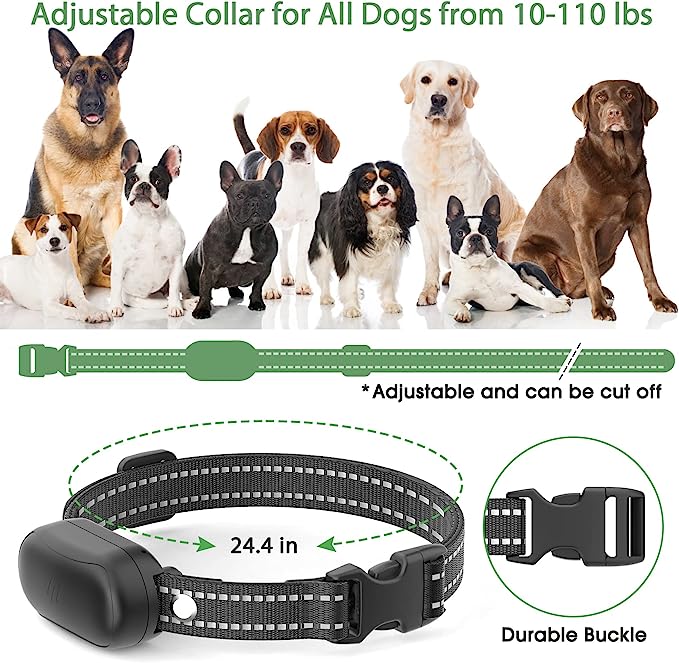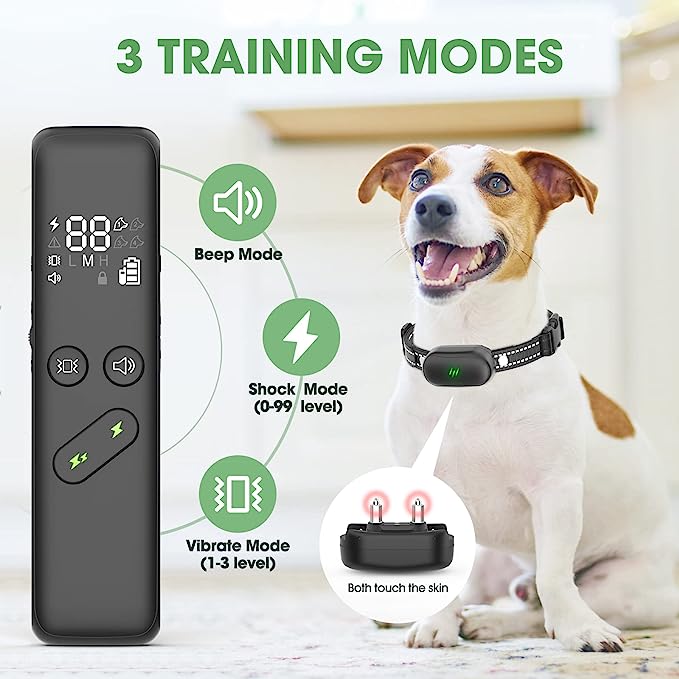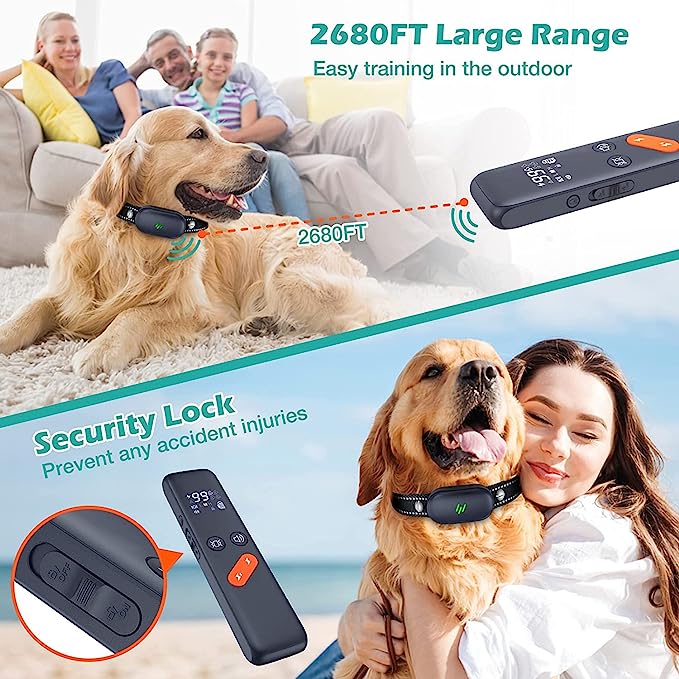Learn how to use a dog shock collar for effective and humane training. Discover the dos and don’ts of using this training tool, and how to properly fit and adjust the collar for maximum safety and effectiveness. Improve your dog’s behavior and build a stronger bond with your furry friend today!
Additional dog training is possible but is only sometimes the simplest or best course of action. Fortunately, there are numerous instruments at your disposal. The shock collar is one of these. But wait, shock collars, aren’t they supposed to be bad? I hear you asking. Whatever you want to call it—a shock collar, an electronic collar, a remote training collar—it all boils down to the same thing. And some people have quite strong views on them.

However, they may be different from what you expect. Utilizing a shock collar can be humane and efficient—at least, in the hands of trained professionals. They are controversial nonetheless. While some contend they are cruel and cause physical and mental harm to dogs, others maintain they are safe and efficient dog training techniques.
They were indeed strong, and the dogs were at risk when they were originally employed to train hunting hounds in the 1960s. Since then, they have undergone significant alteration, and most modern shock collars aren’t as harmful as they once were. However, an electric collar should never be used in place of fundamental training and must always be applied gently. The good news is that lack of care shouldn’t be a problem for your dog because, if you’re reading this, you probably want what’s best!
What Functions a Shock Collar?
Shock collars are bigger than conventional collars and come in various colors and sizes to fit a tiny box and a radio-controlled electrical device. Additionally, a few probes press against the dog’s skin and deliver an electric shock when activated. You can manually or automatically trigger this using a remote control or a proximity sensor.
People mainly object to this jolt, also known as a stimulus. Even though the word “shock” conjures up unpleasant images, these stimuli are meant to be innocuous. Most shock levels are akin to a light tickle while being strong enough to grab a dog’s attention, except for the maximum setting, which might pinch a little too much.
But what if you vehemently object to applying a shock?
Alternative correction techniques, such as sounds, sensations, and odors, are typically included with shock collars. The scent alternative, meanwhile, might not be as innocuous as you assume because dogs’ sense of smell is much more acute than ours. Shocks, sounds, vibrations, and smells can change intensity.
How to Introduce a Dog to a Shock Collar
A shock collar can help you train your dog effectively. They require some preparation, though, and are not magical.
First, shock yourself.
Try the new toy on yourself before putting it on your devoted dog. Because if a shock is too powerful for you, think how much worse it will be for your tiny furry friend!
Learn the Foundations
The next thing to do is to make sure your dog is capable of following simple obedience commands like “sit,” “lay down,” “stay,” and “come.” Try to familiarize them with clickers and vocal markers; for instance, they need to understand that saying “yes” or “good boy” indicates success and the possibility of receiving a treat.
These are important actions you must perform before employing a shock collar. They aren’t employed for the suppression because doing so could negatively impact your dog’s personality and mental health. They should be utilized to communicate successfully with people, not to prohibit inappropriate behavior, but to motivate more compliance.
Take your time
The key is to move slowly. A common question is when a dog is old enough for a shock collar. Although, in theory, they can wear one as early as ten weeks old, it is advised to wait until your dog is at least six months old.
Start the stimulation on a low setting when they initially wear their new accessory to ensure it is not uncomfortable. If they don’t feel it, gradually increase the pressure until they do; if they do, they might suddenly alter their countenance or perform that cute head cock.

But keep in mind two things:
-Larger dogs may require higher doses but start low.
-Be aware of your dog’s emotional sensitivity; anxious dogs may be more receptive.
Keep in mind that it will take time, so have patience. Since your dog has a big, hefty shock collar around their neck with a few protruding contact points, it must get used to it. If they don’t comply, do not, under any circumstances, increase the intensity. Your dog will only experience pain and fear as a result. And they can even get worse rather than better in terms of adherence. Additionally, it will destroy the crucial link between the two of you.
Create these to resemble collars.
Shock collar use is comparable to fundamental positive reinforcement training and the understanding that they will receive a reward if they comply. They know they must act immediately to receive a reward when they sense a stimulus, such as a shock, vibration, smell, or sound.
To get them started, you need to make them accustomed to and enjoy it. Try buzzing it once, saying something encouraging (like “Yes!”), and then rewarding it. The greatest method to get children to link the stimulus with a reward is doing this.
How to Use a Shock Collar to Train a Dog Correctly
Training your dog to utilize a shock collar effectively can be difficult after they have become accustomed to their new device. Consider each step as you go, and watch your dog’s reactions.
- Invest in high-quality goods
A good shock collar makes life simpler for you and more comfortable for your dog. Poor-quality equipment may shock your dog inconsistently, or even worse, and it may malfunction and shock him randomly.
So, buy your dog the greatest collar you can. We know that even a cheap shock collar can be rather expensive, but high-quality items are still available for a variety of budgets. So, start by doing your research!

- Begin with the Foundations
It takes effort; a shock collar won’t magically change their behavior. Start slow and go over basic commands like “come,” “lay down,” “sit,” and “stay” with them.
Recall the power of positive reinforcement; use the same vocal marker, such as “Yes” or “Good boy,” and reward them with their preferred foods. This is the greatest approach to begin; if it results in goodies, your dog will be more receptive to utilizing the shock collar and will continue to trust you.
- Model the Behavior You Want for Your Dog
Don’t just buzz your dog when they misbehave or disobeys commands. They won’t learn anything from this; instead, it frustrates and confuses them. And that’s not what we want! Instead, only mark when they behave well and receive a treat using the shock collar.
- Couple positive reinforcement with the collar
To achieve this, they must link the shock collar to positive reinforcement, much like when using a clicker. Because they know a treat is coming, they immediately pay attention to you and comply when they sense that buzz. This is negative reinforcement if the shock collar is only used to stop undesirable behavior. And the result could be the reverse.
- Set the Collar to “vibrate Mode.”
On older shock collars, the shocks have changed (thank goodness). However, you should avoid the shock or fragrance options and only use the vibrate or sound mode. Your dog is safe and content, thanks to this. Therefore, choose the greatest vibrating dog collar for your pet. You may gradually turn down the shock setting if you first need it so it’s only on vibrate.
6. Knowing When to Seek Assistance
What if your dog isn’t understanding? Whatever you do, resist getting impatient, frustrated, or raising the corrective level. This won’t help dog training and exacerbates your bond with your pet. Finding a qualified trainer might be worthwhile if you’re having no luck. Professional dog trainers are experts at getting the most performance out of dogs and frequently know of these resources. If in doubt, a qualified trainer can instruct you on how to shock-collar teach a dog.
You’re already complaining, “But hiring a dog trainer is pricey!” True, but it’s worth it if your dog’s safety is in jeopardy. They’ll also offer you advice on how to keep doing it yourself. And if you have the cash for a good shock collar, you probably have some left over for a dog trainer.
- Recognize when to stop
Remember that a shock collar is not intended to be worn continuously. Imagine having those points of contact with your skin all day long. If you’re not careful, your dog could end up with sores. When shock collar training, it’s best to use them briefly before removing them.
Another thing to remember is that every dog is different. Although employing a shock collar might be effective for some dogs, there is no guarantee that it will work for you. It can be worthwhile to discontinue if your dog is very sensitive and not loving the collar.
What Else Can a Shock Collar Teach Your Dog?

Although shock collars only do one thing, they’re adaptable instruments that may be utilized in various ways. A shock collar is most frequently used to improve fundamental training and sharpen reflexes. This is a great technique to master the fundamentals before progressing to trick more difficult sets, especially if you’re hoping your dog will pick up more difficult and advanced talents in the future.
They can also be employed to teach walking off-leash. Everybody has seen the pets and dog owners they want to be. Those cool people, you know, who just let their dog off the leash in the knowledge that they won’t let him run off, get lost or bother other dogs. Shock collars can be a helpful stepping stone, even though they won’t get you there immediately. Even some people consider electronic collars to be a physical leash’s replacement.
Shock collars offer advantages over leads, particularly in busy dog parks with plenty of other canines. How frequently do leads tangle when they are near other people? That put an end to my shock collars! Using shock collars for invisible fences gives your dog some freedom while still having a barrier, although one you can’t see.
Shock collars are connected to an underground wired boundary, a radial boundary from a radio transmitter, or even GPS when utilized as invisible fences. Your dog is given a brief shock or vibration that signals them to halt and remain in its safe region if they venture outside the bounds. Shock collars are frequently used to curb undesirable behavior. Although we adore dogs, they can develop harmful tendencies. Some people pull on the leash, and others snap or bark at them. My dog is a big barker.
Shock collars can assist in communicating what’s not okay and serve as a gentle reminder of appropriate behavior if any of these troublesome behaviors get out of hand. Shock collars are also beneficial if you want your dog to have some athletic potential. An agility course involves more than just climbing and jumping over obstacles if you’ve ever watched a dog attempt one. These canines must be proficient at obeying directions rapidly because there is a timing component.
One method for assisting them to respond to commands quickly and successfully and earn more medals is using shock collars. Lastly, trainers prepare dogs for work by using shock collars! We’ve all seen dogs with more interesting occupations than our own, such as bomb-sniffing canines and canines employed by the police or military. Although we can’t tell how much training is involved, shock collars are frequently used.
Final Reflections

A shock collar is a potent training tool, even though it may be debatable for some people, provided it is used properly and for the intended purposes. They make it possible for you to converse with your dog clearly despite great distances and possibly distracting environments. Training using a shock collar can instantly get your dog’s attention and provide amazing results.
Remember that a shock collar should never replace positive reinforcement, which is the cornerstone of all training techniques. In the end, your dog’s pleasure and well-being are far more crucial than its level of obedience. In the end, what matters most is your relationship with your dog, so make sure that utilizing a shock collar only strengthens it.
